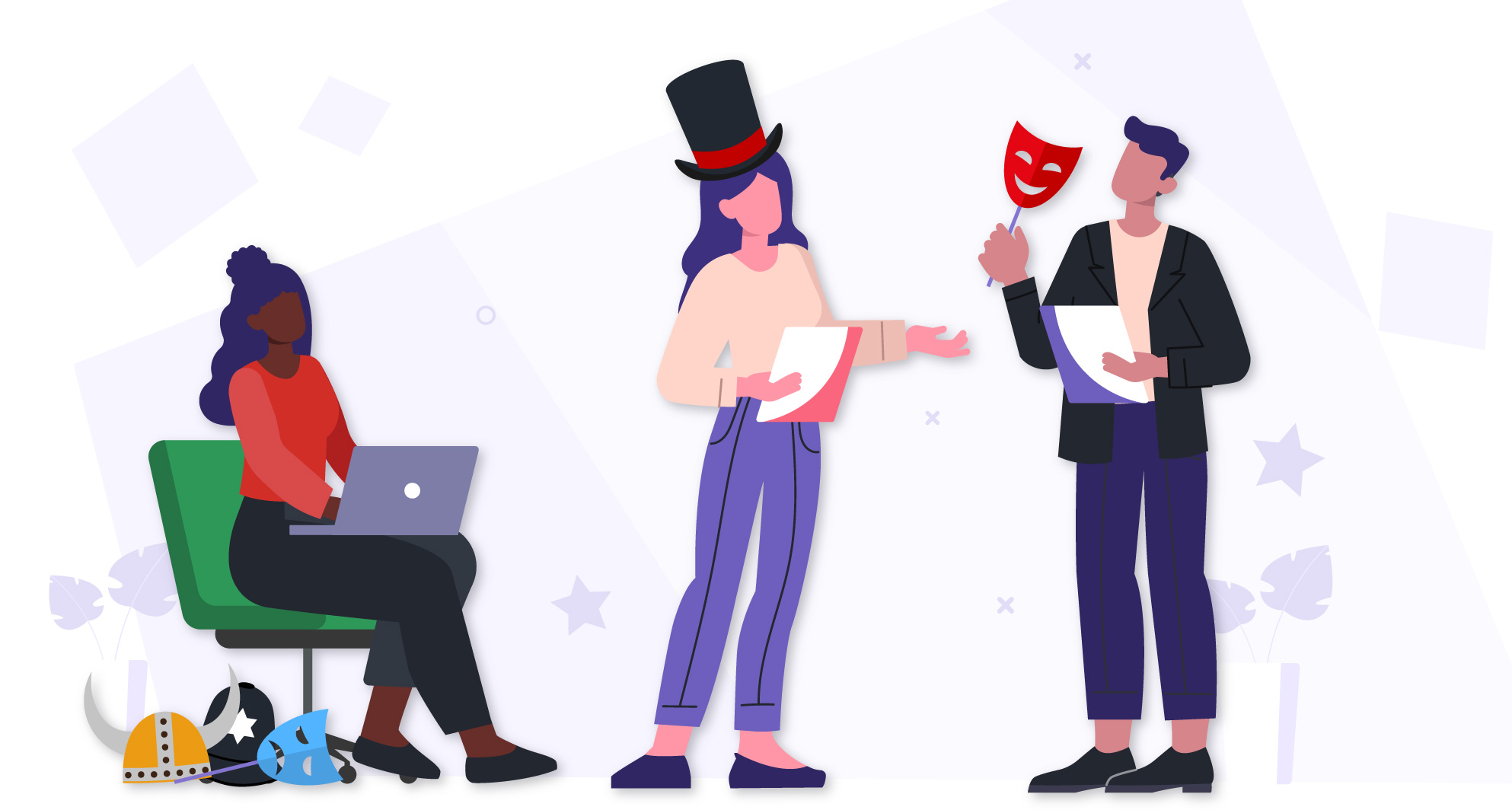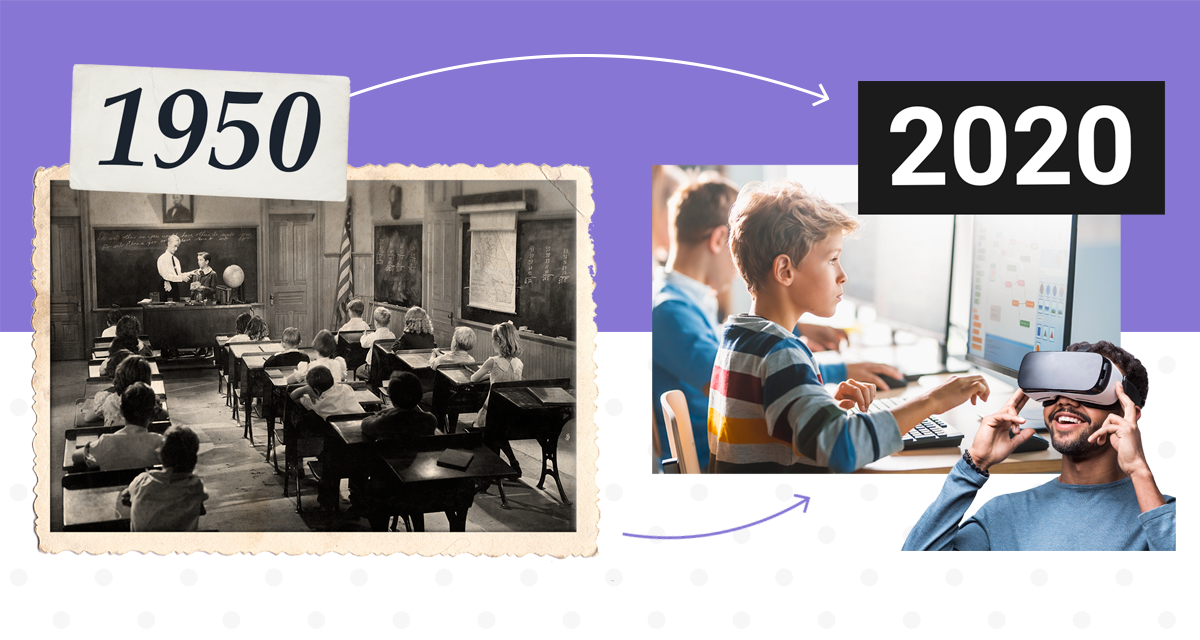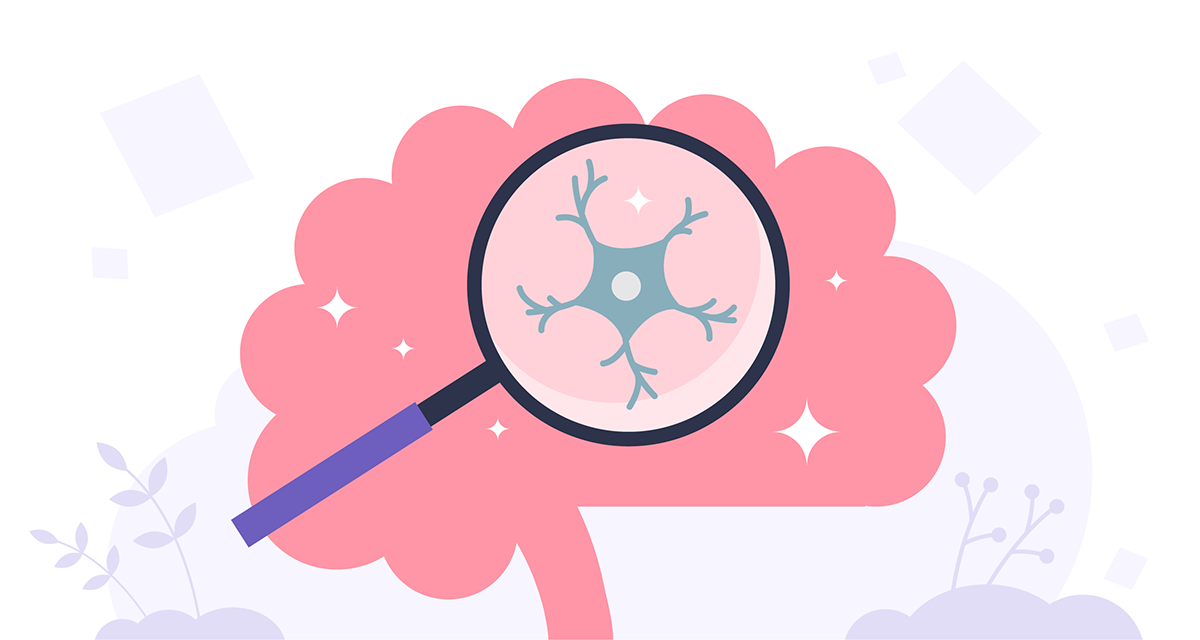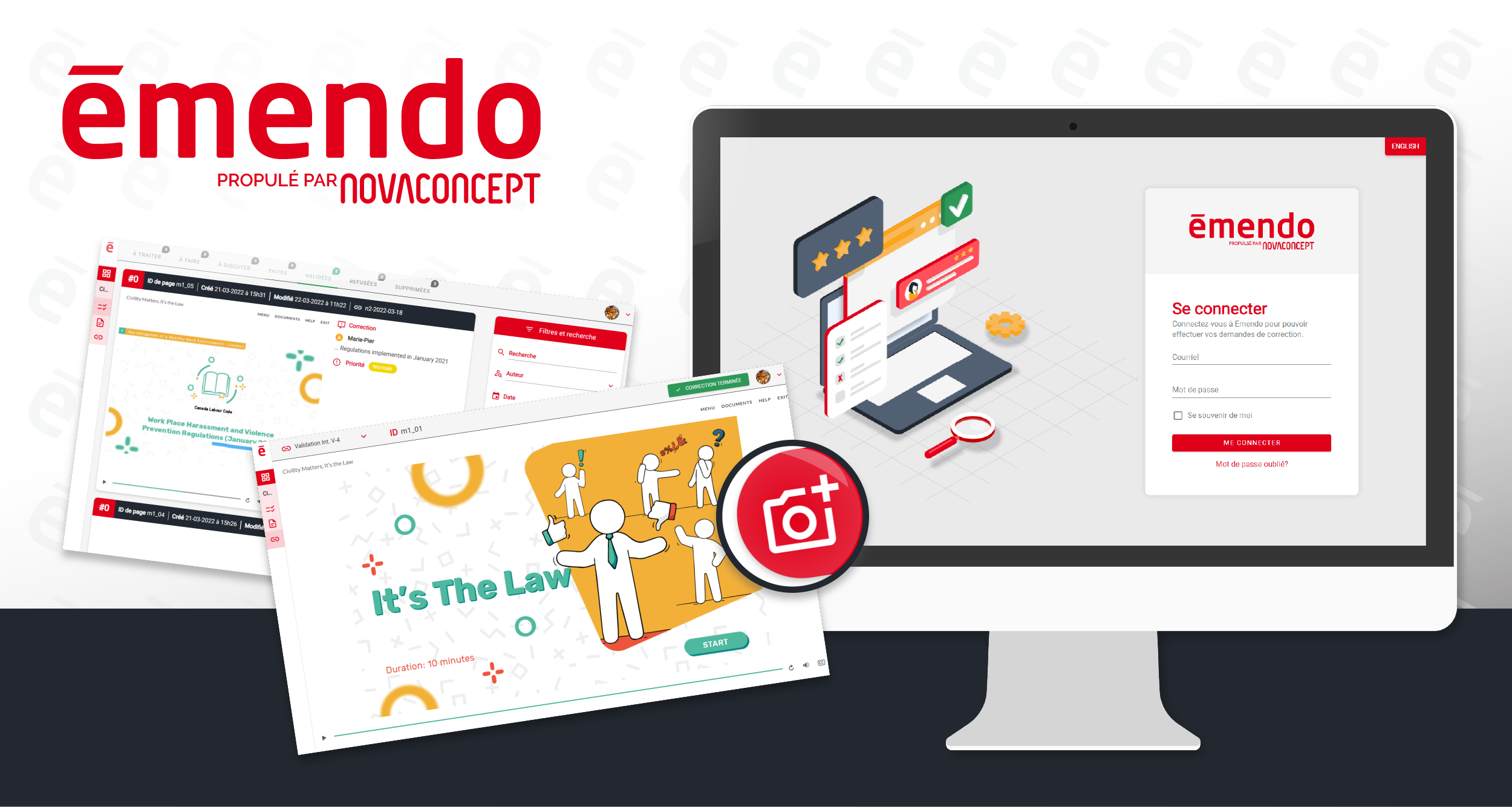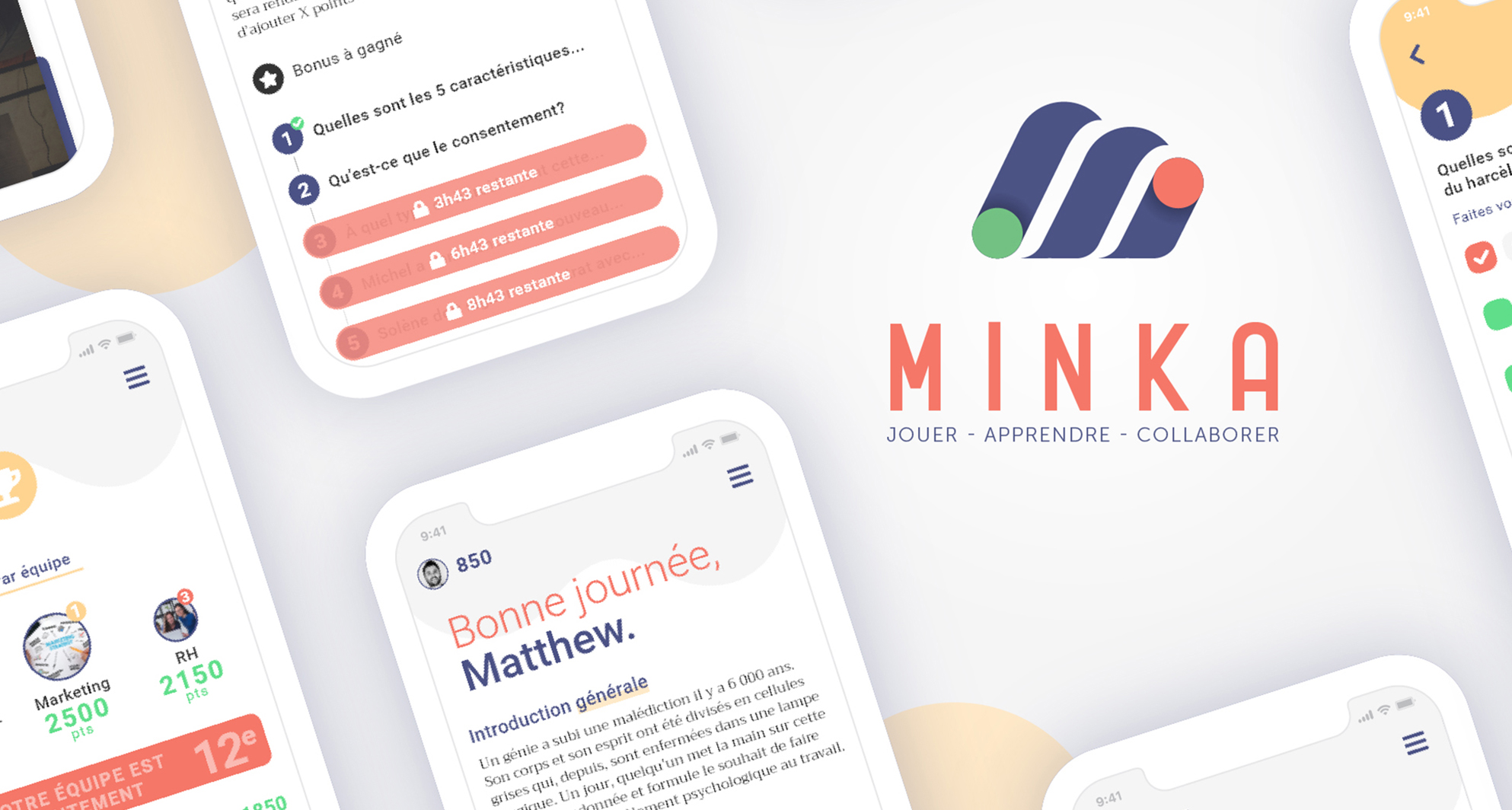Reacting to the past to shape the future
One presentation in particular caught our attention during our visit to the Numérique 2022 conference at HEC Montréal, last May. Two philosophy teachers from Collège André-Grasset shared how they use the game “Reacting to the past” to put into practice the philosophical ideas discussed in class.
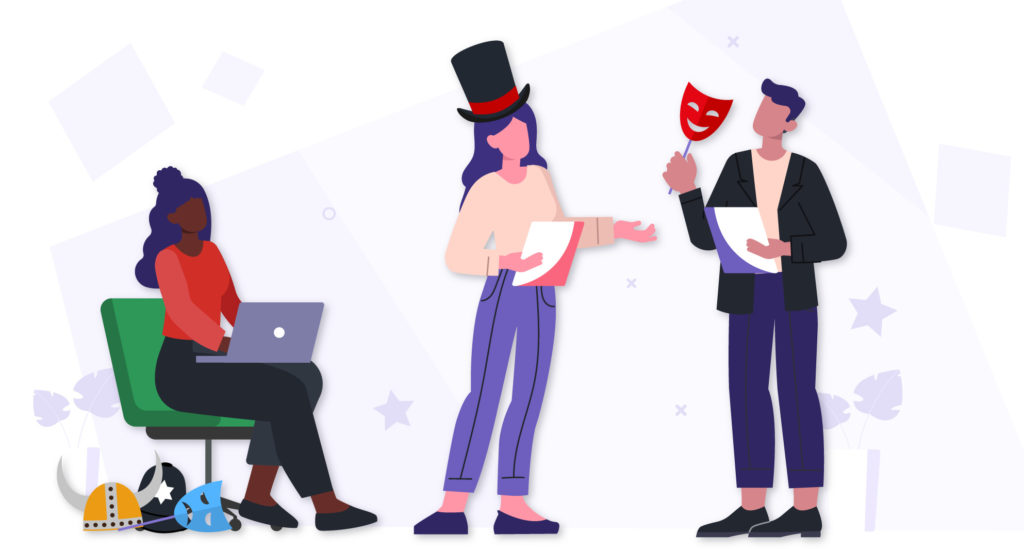
The concept :
“Reacting to the past” is a competitive role-playing game based on historical events. The objective is to recreate a key moment in history, for example the French Revolution, by playing the relevant historical parties. Each participant receives a card with the role they will play. The card details, among other things, their political positions, their values and the objectives that the participant must try to achieve (for example, passing a law). As the game progresses, each player must react to the announcement of real historical events (riots, attacks, accidents, etc.) according to what is on their card. Archive articles can also be used, or press briefings staged, to introduce a historically realistic media presence. To achieve their objectives, participants must give speeches and make alliances. Will they make the same decisions as their historical predecessors or can they change history?
A role play-based pedagogy
This pedagogical formula, increasingly used in the workplace, puts participants in a fictitious yet realistic situation where they must apply their knowledge and in which their decisions have consequences (fortunately, not real ones!). This approach, seen in online training, makes it possible to apply theoretical ideas in a safe environment. Using events that have taken place within your company (managing a project involving a large number of people, for example) or an external event that had a significant impact on your operations (such as the ice storm), provides you with tangible elements to react to and upon which to base your decisions. This can help you to better understand the strengths of your teams and which situations may require more preparation.
What kind of situation would you like to prepare your teams for?
Has this article piqued your interest? Do you want to discuss e-learning solutions tailored to your needs? Get in touch now using the form below!
This site is protected by reCAPTCHA and the Google Privacy Policy and the the Terms of Services apply.
The Last 70 Years in Education: What’s Changed?
What a meteoric evolution education has had in less than a century! In the 1940s, there were some 4,000 schoolhouses in Quebec. Today, new technologies such as tablets and interactive whiteboards have invaded classrooms, not to mention the possibility of learning remotely! What are the greatest transformations that have left their mark on education and continuing education since the end of the Second World War?
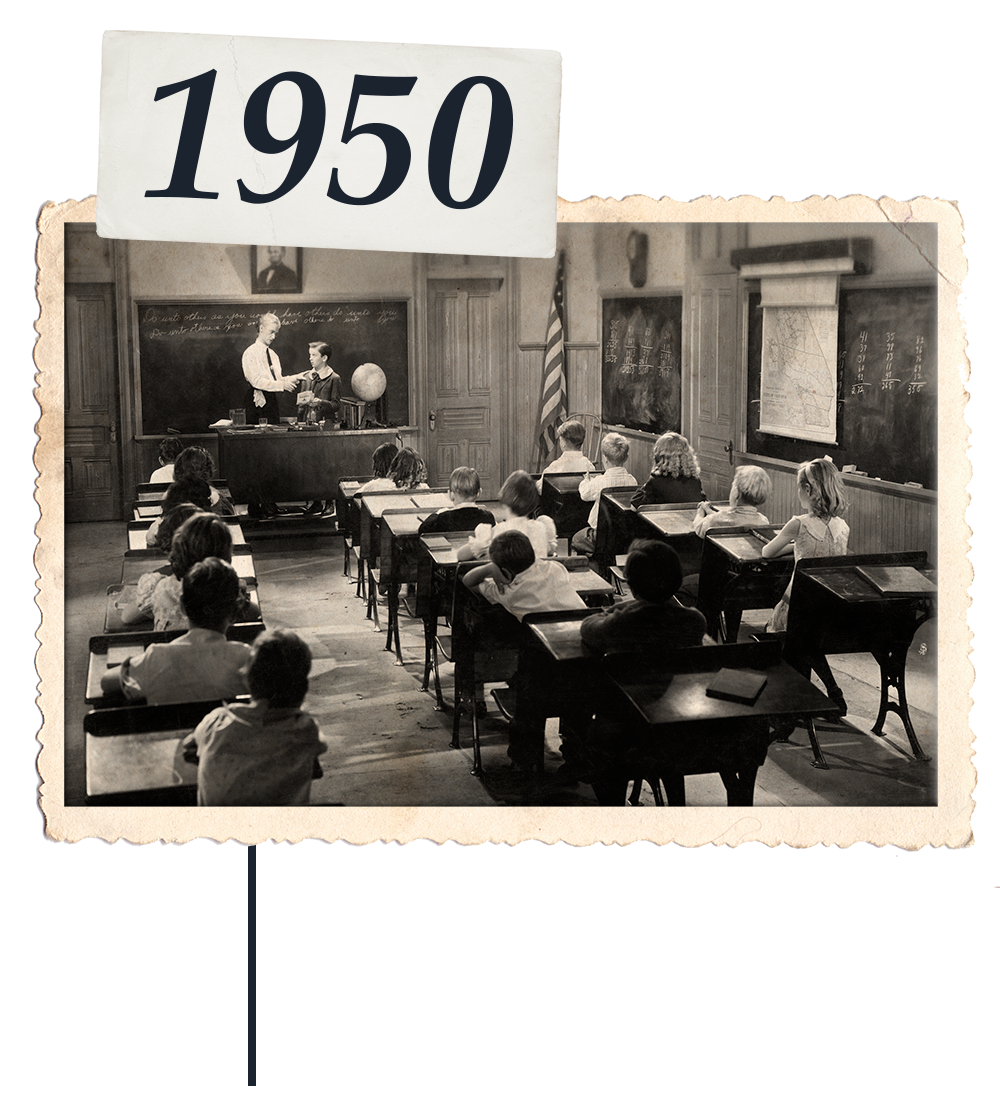
1950 : At that time, educational posters, like geographical maps and the periodic table, were a decoration staple in classrooms, and the smell of chalk hung in the air. The walls were otherwise unadorned in order to avoid as much as possible any distractions that could interfere with the students’ focus. However, during this decade, the educational model started to shift. Until then, students had to adapt to the school’s way of doing things, but it was then that the relationship reversed. It became understood that educators needed to pay attention to each student’s needs to foster their development. Student individuality was beginning to be recognized, and this showed in school furniture as desks in rows gave way to single desks.
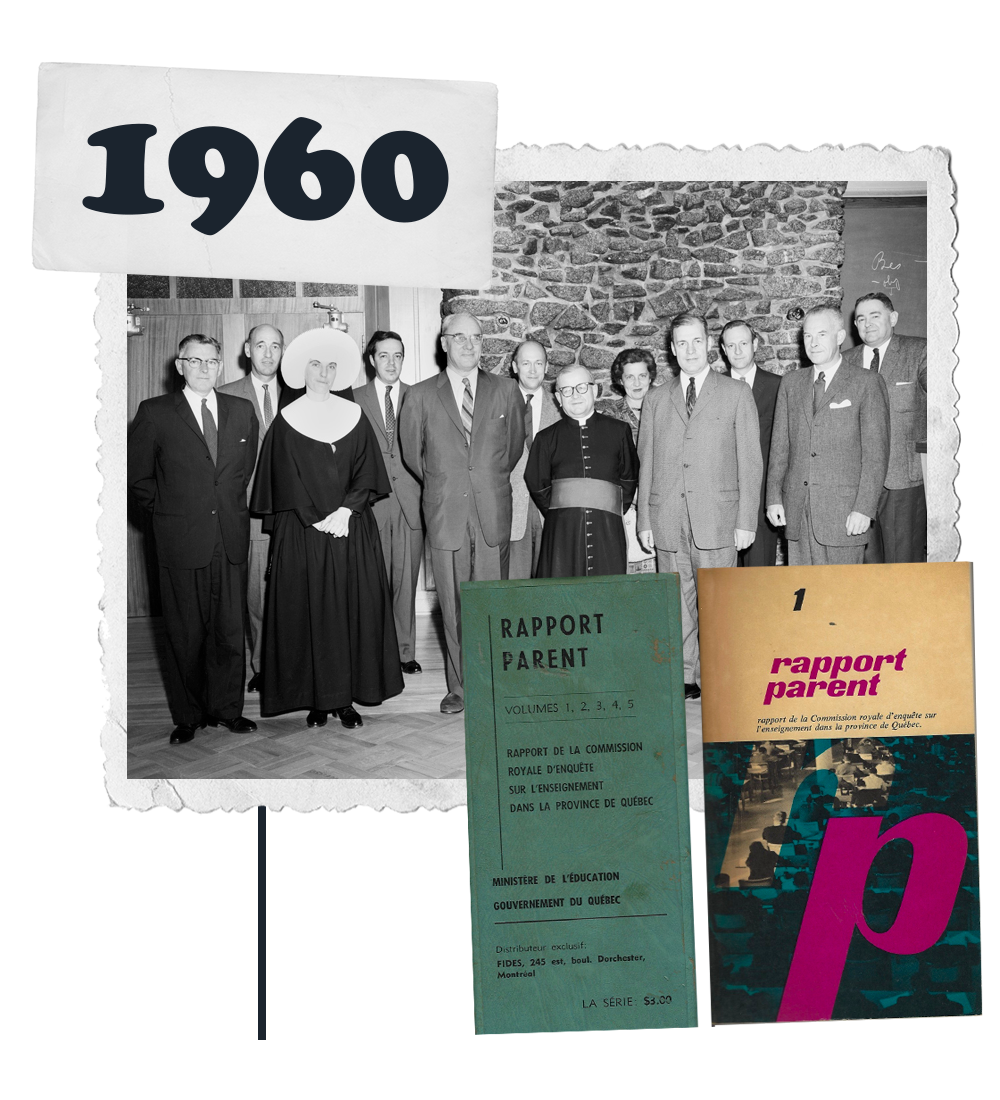
1960 : The Quiet Revolution brought enormous change to Quebec! For education, it’s the Parent Report that made the difference. Its main goal was to democratize school and higher education. The Ministère de l’Éducation was founded, and its mission was to establish high schools and CEGEPs and expand the network of the Université du Québec across the province . That’s a far cry from schoolhouses!
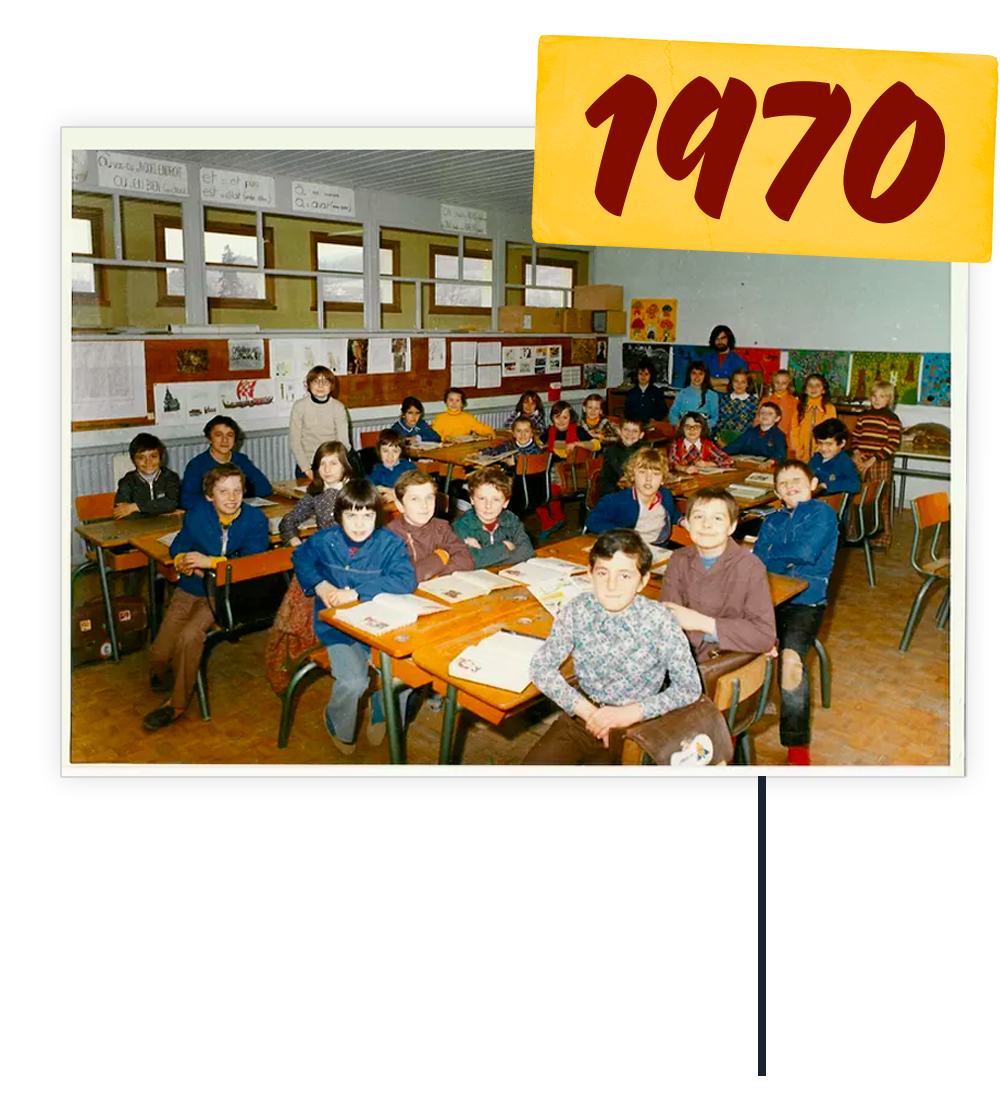
1970 : In addressing student dropout, the government sought to provide a stimulating learning environment that would motivate students to learn. Already present in the workplace, the concept of ergonomics made its way to schools and introduced movable chairs, which are lighter and more flexible, because comfort positively affects focus and motivation. The desks also took on an irregular shape, so classrooms could be set up differently depending on the activity. This way, teamwork and autonomy were fostered, two skills that would be especially useful in the job market.
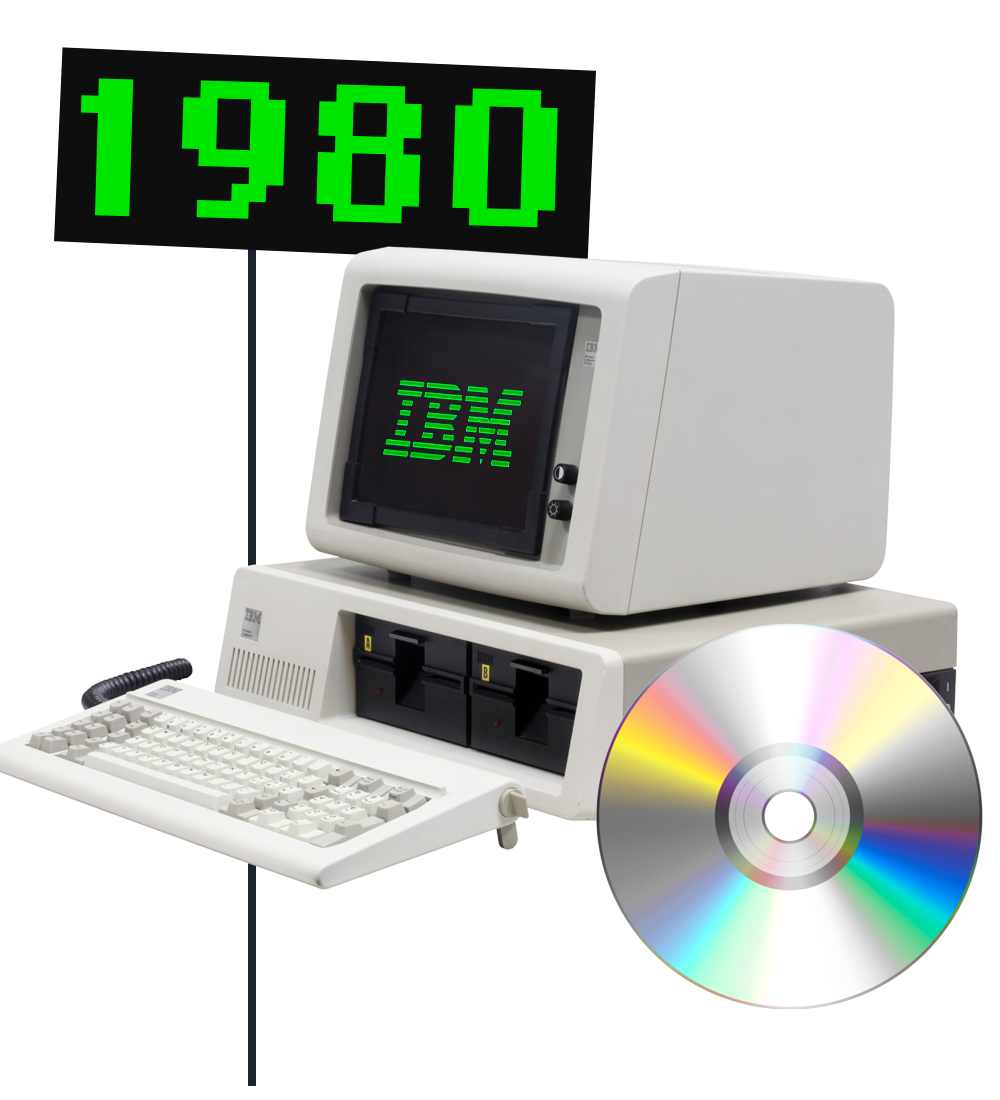
1980 : In 1981, IBM introduced the Personal Computer (PC)! The computer turned into an increasingly important work tool. It made its way into homes, and schools started preparing for its arrival. The launch of multimedia CD-ROMs precipitated a greater use of the personal computer. Among other things, CD-ROMs helped people learn different software on their own, where and when it suited them. It made it possible to rethink continuing education. It was no longer necessary to travel to update your skills and knowledge. Digital technology allowed for greater flexibility in training.
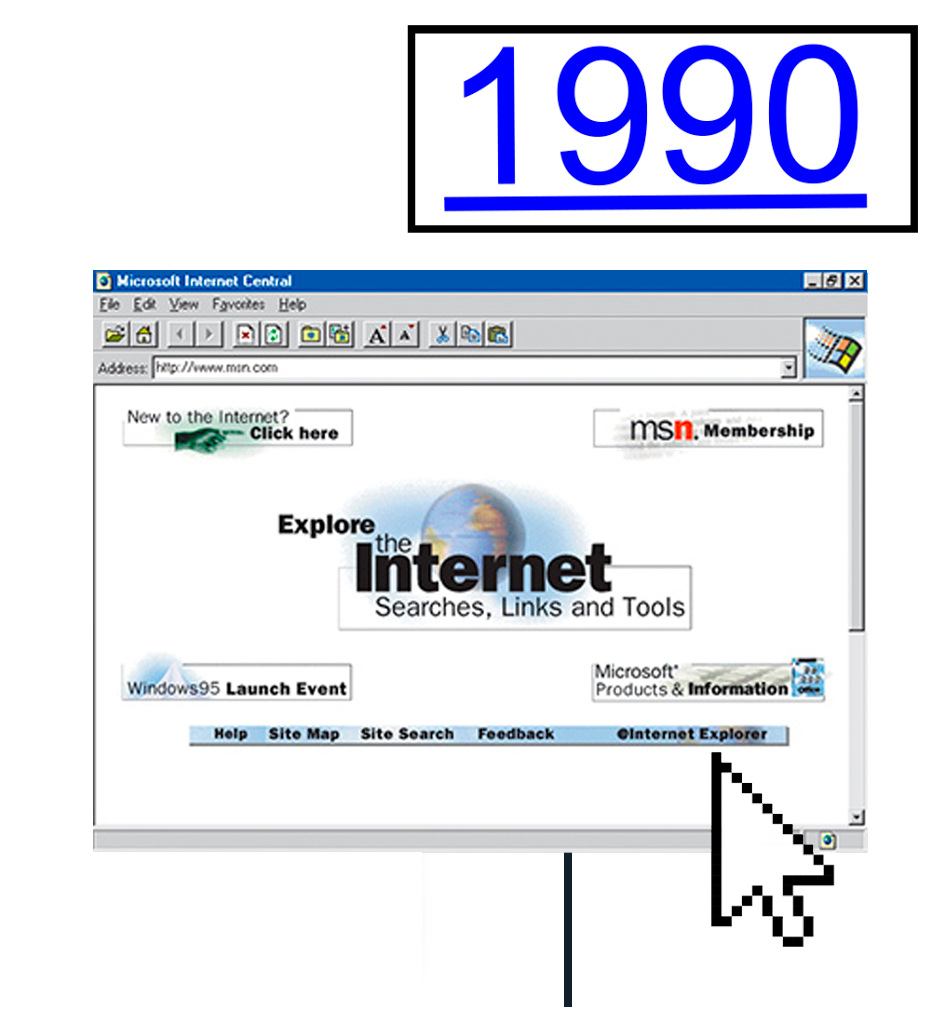
1990 : INTERNET

2000 : The internet’s arrival opened up a world of possibility! In the education industry, learning management systems (LMS) made it possible to complete online courses from one’s own computer. It then led to the development of Massive Open Online Courses (MOOCs), which aimed to provide high-quality education, often for free and in a collaborative format. This way, no matter where we were in the world, we could improve our knowledge! Provided we had an internet connection, that is. The professional community also benefitted from this fantastic innovation. It was a formula for accessibility that was both efficient and affordable.
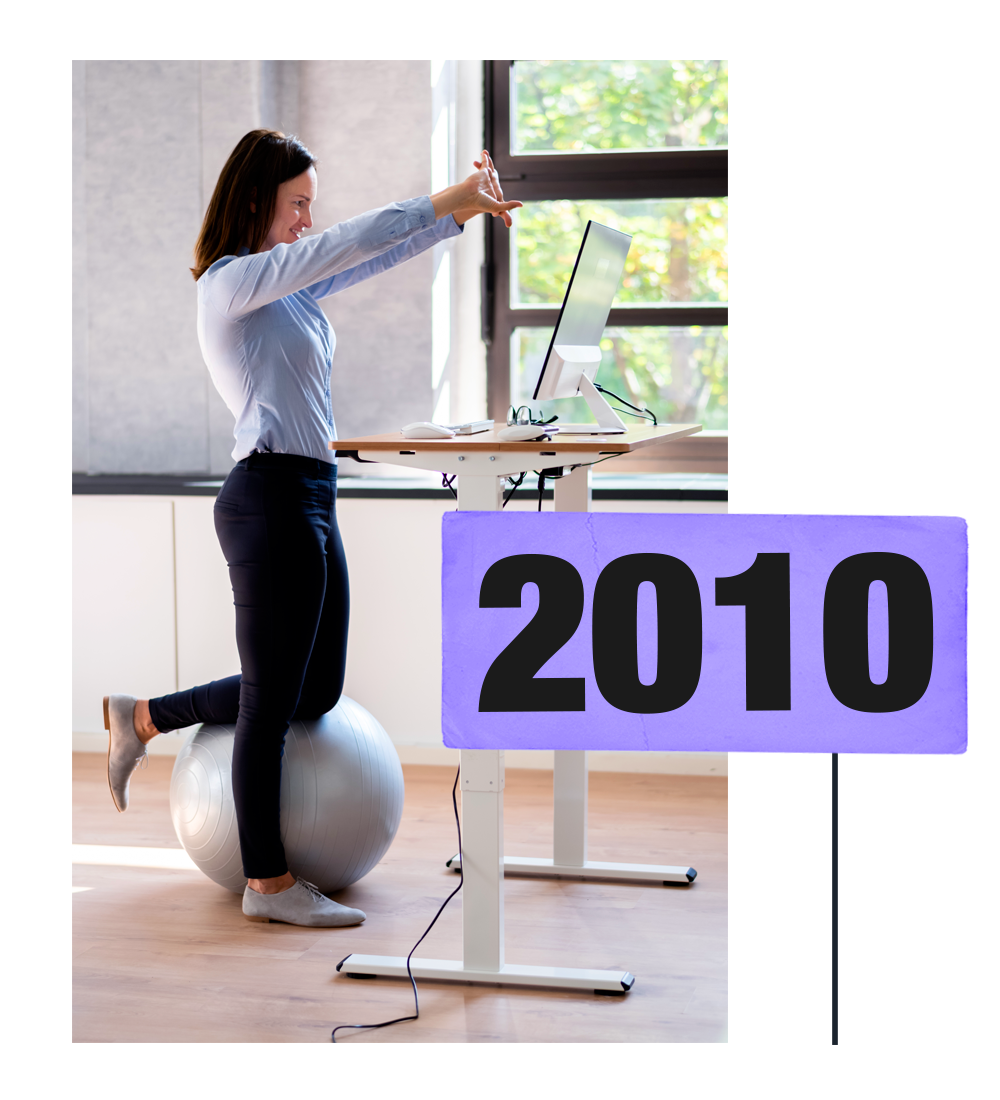
2010 : Well-being and mental health concepts became an increasingly important part of our value system and changed how we learn. Flexible classroom designs made their way into Quebec schools. Why? To improve student comfort and improve focus. Not everyone performs the same under the same conditions, so it’s important that different options be available for everyone to reach their full potential. We see the same trend in the workplace with more adaptable office spaces (possibility to work standing up, on an exercise ball, etc.) and flexible working hours.
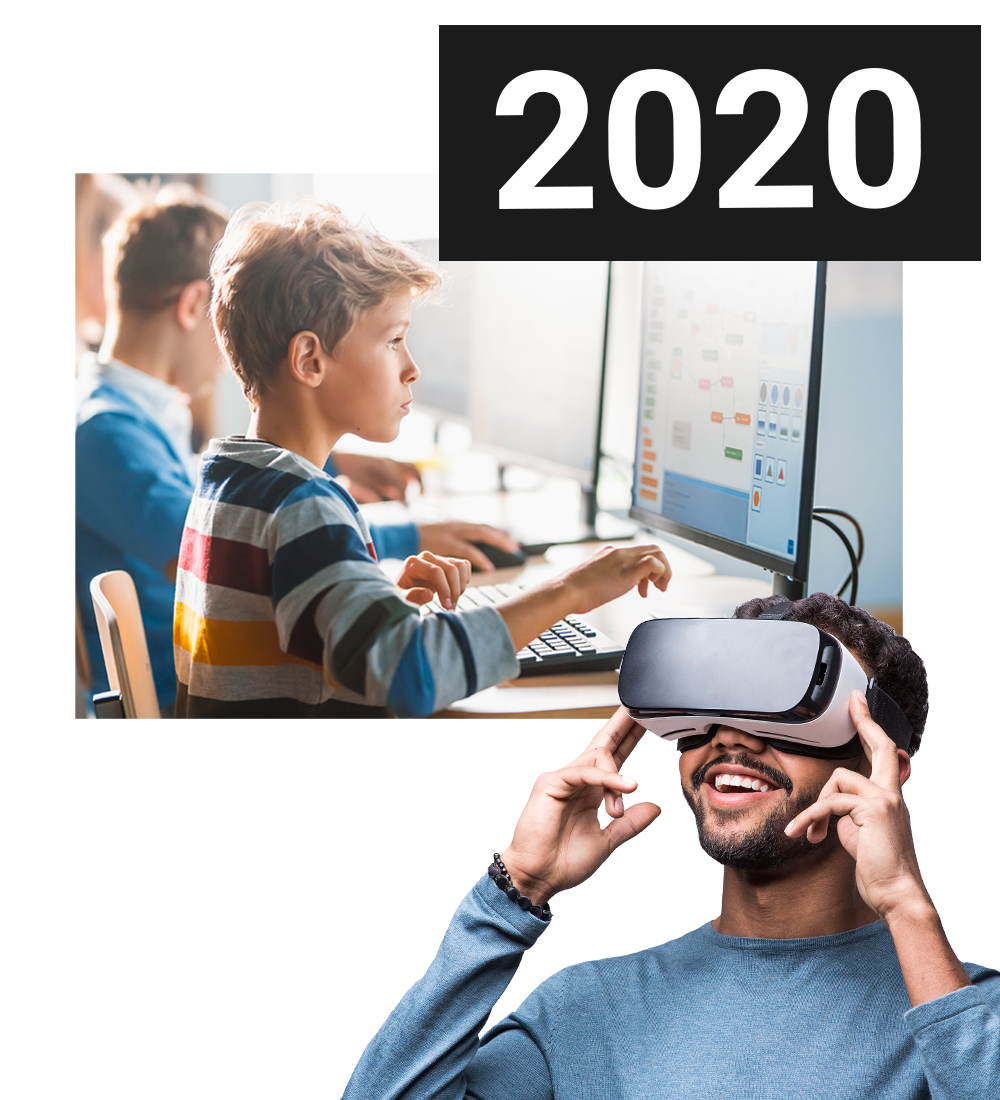
2020 : What lies ahead for this decade that was catapulted into remote learning and working? More than ever, digital technology is an integral part of how we learn, but to be able to navigate this online world and face the challenges it presents, new skills are needed. That’s why we’re seeing so many programming classes for every age group and in every field. It’s imperative that we understand the inner workings of the tools we use every day and that are central to our work. Including programming courses in school curricula or learning a computer language on one’s own through e-learning are but two of the ways to accomplish this.
It’s clear that, in the last 70 years, the world of education has changed significantly! Far from the austere classrooms of yesteryear, where religion made up most of the curriculum, today’s classrooms are flexible, stimulating and high-tech. Adult education also evolved in this direction. Online and customized trainings are now must-haves. Novaconcept was able to adapt and make the most of all these innovations. We’ve come a long way from our CD-ROM trainings to our recent projects where we use 360⁰ visuals and augmented reality! How far can we take your training projects?
Contact Us!
Has this article piqued your interest? Do you want to discuss e-learning solutions tailored to your needs? Get in touch now using the form below!
This site is protected by reCAPTCHA and the Google Privacy Policy and the the Terms of Services apply.
Guiding Your Teams Through Their Online Training
Continuing education has become a cornerstone in the job market. It helps us stay up to date in a world where knowledge is constantly changing. It’s also a great way to improve our professional practices—as long as we leave nothing to chance. As a manager, you can help your teams get the most out of each online training session. Here are a few tips you can use before, during, and after online training for best results.
A supportive learning environment
For your team to get the most out of their online training, you need to set up optimal learning conditions. First, you need to know your performance objectives and clearly communicate them to your team.
Ask yourself the following questions:
- What is your training topic?
- Why is it important to update your knowledge on this topic?
- Which skills will this training help sharpen?
When your team knows the company’s motivations and goals, they can understand the value of the training and more easily identify when they can apply this new knowledge. If you’re having trouble setting your goals, our expertise in instructional design can help you identify your needs and the best way to meet them.
For your employees to give due attention to this training, they need to see that you value it as much as they do. Ask them to set aside time in their schedule to attend the training, just as they would for a mandatory meeting. Scheduling a time to take the training helps organize tasks and fosters learning. You can also build an optimal learning environment by sharing best practices to limit distractions and keep your team focused throughout the training. You can suggest, for example, that they close their email, put their phone on silent, set their TEAMS status to “Do not disturb” or tell their colleagues that they won’t be available during the training period. Making it possible for every team member to focus throughout the training will lead them to take the training seriously and to absorb the new information better.
Behaviour during training
You can also ask your team to be active throughout the training. When it comes to developing new skills, being passive is not enough. Here are some tips for promoting engagement during online training:

Whether it’s keywords, a graphical representation of a concept or a summary of a new process, the important thing is that they make the training content their own by explaining it in their own way.
Its a simple way to stay alert throughout the training. The goal is to learn new things, so testing their understanding by immediately applying what they’ve just learned is crucial.
Mistakes are part of learning, and they help us make progress. If your team members get it wrong, it shows they are committed to the training and try to apply what they are learning. Remind them that there’s always room to learn and improve.
Knowledge retention is better when people think it’s going to be helpful in their day-to-day. This helps quickly refresh what they’ve just learned.
Reactivate the new knowledge after training
Your work is not done once your entire team has finished the training. The next step is to put this new knowledge into practice in the real world.
The first step is to ask your team members to discuss what they’ve learned during and after the training. You could, for example, create a TEAMS channel, a forum or even have a short meeting. Discussion between colleagues helps confirm understanding, consolidate learning, and make it easier to form connections between past and new knowledge. The second step is to use this forum for concrete examples of where to use this new knowledge. You can also present scenarios and ask your staff what the best approach is, based on what they’ve just learned. The more quickly and regularly people use new knowledge after training, the more fully they will master it. In addition, the forum will show your team how relevant the training was by reminding them of the goals you presented at the beginning of the process. You can plan this kind of reactivation and learning consolidation activity with our instructional design team and use it when the time is right.
These tips will help you create a learning culture within your team or company while encouraging your staff to continue their professional development! Acquiring new knowledge and developing new skills that the learners will quickly put into practice is a net positive for their confidence and creativity. You also encourage your team to be proactive by finding solutions and rethinking their work methods to be more efficient. Ongoing training has become a must because it allows learners to continue their professional development, and companies to face new challenges in creative and innovative ways. And Novaconcept is there to help you achieve these two complementary goals!
Contact Us!
Has this article piqued your interest? Do you want to discuss e-learning solutions tailored to your needs? Get in touch now using the form below!
This site is protected by reCAPTCHA and the Google Privacy Policy and the the Terms of Services apply.
Let’s get our neurons working!
You’ve been wanting to learn to play a new instrument or to use new software for a new job since the year began. You’re trying, but it’s not a resounding success. You tell yourself it might be too late to learn new skills or master new technologies. Think again! You do have everything you need to keep learning!
Our brain constantly changes, adapts and evolves based on what we’re learning, our environment and what we do. Your brain’s malleability is possible thanks to something called neuroplasticity. These changes alter how our neurons communicate with each other throughout our lives. This communication, activated by processes, affects memory and supports learning. Each time neurons activate and communicate with each other, their connection strengthens. Our new experiences, whether it’s at work or in a language class, multiply the links between our neurons and let us learn throughout our lives. At Novaconcept, continuous learning lets us help our clients reach their goals by creating training programs adapted to their needs.
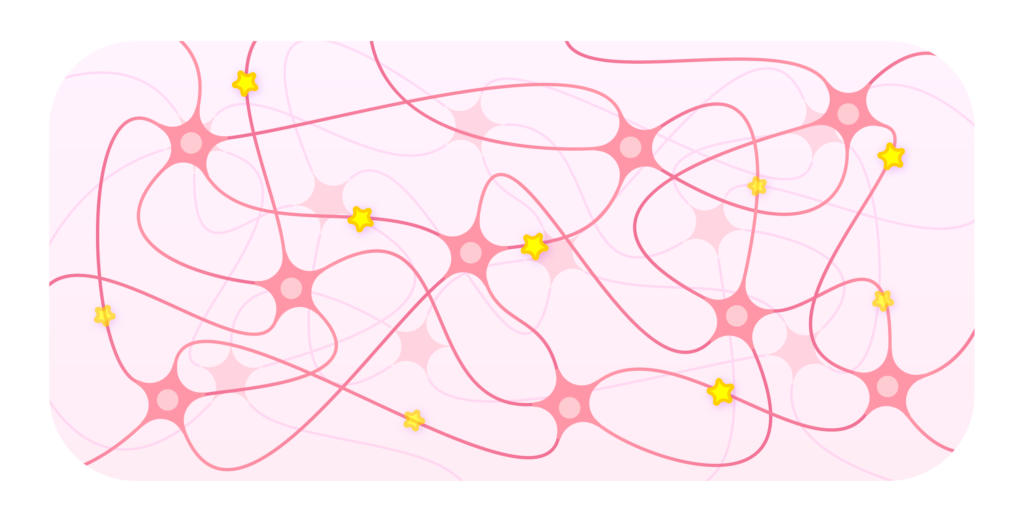
Neuroplasticity and Learning
Neuroplasticity is an ability that highlights the capacity to improve and learn. Let’s use a concrete example to understand the concept of neuroplasticity better.
Imagine that you just arrived in a new city. You need to drive to the grocery store. The first time you leave your home (point A) to go to the grocery store (point B), you keep your eyes glued to your GPS. The next time, taking your eyes off your phone is easier. After a while, you feel more comfortable, and you almost know the route by heart. It becomes automatic for you, meaning neuron A and neuron B talk to each other just as easily as you make the journey from point A to point B. One day, though, you’re going to the grocery store, and the street you usually take is closed. You’re surprised and decide to take a new way there. You need to focus and find a new path to the grocery store. A new connection between neurons A and B is born!
 As you can see in this image, practice is key to keeping the route in your head while paying attention to everything around you. This also applies to your learning! The more you practice, the more your neurons talk to each other. They strengthen each other and make learning easier. On the other hand, if you’re learning something new, you neurons will need to work harder to communicate. Moreover, if you stop practicing, little by little, the communication slowly breaks down and disappears from your memory.
As you can see in this image, practice is key to keeping the route in your head while paying attention to everything around you. This also applies to your learning! The more you practice, the more your neurons talk to each other. They strengthen each other and make learning easier. On the other hand, if you’re learning something new, you neurons will need to work harder to communicate. Moreover, if you stop practicing, little by little, the communication slowly breaks down and disappears from your memory.
Lack of sleep, anxiety and lack of motivation are barriers to new connections between neurons. When these barriers stack up, we find ourselves in cognitive overload. These factors can make your learning more difficult.
How can you avoid cognitive overload and optimize your learning?
Have you ever tried to read a book while listening to the radio? It’s pretty hard! This is because working memory has a limited capacity. As soon as you reach this limit, your brain stops learning. We call that cognitive overload. Even though there are factors that we can’t control when we’re in a learning situation, there are still things we can do to reduce our cognitive load:
- Have a development mindset: understanding that we develop skills through perseverance and effort and that there’s always room for improvement.
- Reduce distractions: turn off phones, turn off computer notifications and close the door.
- Begin the training by taking a few breaths to reduce our level of stress.
- Take breaks.
- Go back to old training courses. Attend other training on the same topic and practice new and old knowledge to create strong bonds between them.
At Novaconcept, we believe in everyone’s neuroplasticity. Our role is to remove as many barriers as possible to make it easier to acquire new knowledge! We can help you master your learning and make your continuous development easier. Our expert instructional design and multimedia production teams developed several strategies to streamline learning. When we create training, our experts ensure information is structured to develop good neural networks in your brain. We use a variety of teaching approaches to activate your neurons and we create thoughtful and quality graphics.
Lastly, it’s together that we’ll continue to learn effectively.
Sources :
Blog Post | Neuroplasticity (alicedilemma.github.io)
La-neuroplasticite-au-service-de-lapprentissage.pdf (aqep.org)
After watching this, your brain will not be the same | Lara Boyd | TEDxVancouver – YouTube
Neuroéducation : comment maximiser le potentiel du cerveau de ses élèves | UQAM
Contact Us!
Has this article piqued your interest? Do you want to discuss e-learning solutions tailored to your needs? Get in touch now using the form below!
This site is protected by reCAPTCHA and the Google Privacy Policy and the the Terms of Services apply.
E for Emendo
While working with us on training projects, you’ve probably already clicked on the small “e” in the upper right-hand corner of the online training courses that we delivered so you could validate them. By doing that, you’ve used our in-house correction management tool: Emendo.
Our very own programming team developed this discreet, but oh-so-useful, app and is doing a remarkable job of streamlining our technological processes.
We’re continuing to develop our Emendo tool to add several new features as part of our continuous improvement approach. In technical terms, let’s say we’ve “evolved our Pokémon” and it’s not as easy to miss now.
Here’s what’s new after Emendo’s evolution:
- The platform was completely redesigned to provide users with an intuitive browsing experience.
- The comment panel now has new options for clarifying requests and improving communication. For example, you can now draw arrows to point out elements or draw rectangles to frame an area on screen. You can also use labels to indicate whether the correction relates to narration, visuals or on-screen text!
- We added the Correction Finished command that automatically notifies Novaconcept that the validation round is officially finished.
- Sorting correction requests is now easier thanks to filters. You can filter requests by author, creation date and label type (e.g., narrative, visual or on-screen). This same sorting feature is also available for downloadable reports!
- Previous validation link versions can be accessed at any time to follow the evolution of the course from round to round.
- And much more!
Contact us
Has this article piqued your interest? Do you want to discuss e-learning solutions tailored to your needs? Get in touch now using the form below!
This site is protected by reCAPTCHA and the Google Privacy Policy and the Terms of Services apply.
Cultivating knowledge
It’s said that you reap what you sow. And if we sowed knowledge and learning in a company, what would we reap? A field of full possibilities is open to you. Creating a learning culture in your company, with the right tools and the best advice, is a way of multiplying your resources to better reach your goals.
Learning culture in a nutshell
Continuing to learn and improve on the job are musts for this new wave of workers, whose curiosity and self-guided learning make them key assets to any company. 1
- A learning culture can be summed up as ways of doing and being that value learning new things and developing skills.
- It can manifest in many ways, including formal training, knowledge- and skill-sharing between colleagues, collective thinking on best practices, and organizational development.
- Learning culture requires a climate that’s conducive to innovation and where mistakes are allowed. Challenges are seen as opportunities to practice new knowledge or skills. Learning is everywhere and could happen at any time.
- Feedback during a project or after a training is a lever for change that’s at the core of learning culture. The constructive comments that result from this process lead to adjusting and valuing individual and collective progress.
- Learning culture is cross-sectional. In fact, it can be found in several areas in a company, in each member’s day-to-day, in the various work groups, and elsewhere. It must be put into practice on every level.
Lastly, learning culture is one of the solutions for retaining staff in their respective positions. It appears that staff who have access to diverse types of training supported by their employers stay in their jobs longer. This can be explained by the quality of the work environment, the value placed on expertise and the emotional bond with the company. 2
Some Novatips for a flourishing culture
- Plan a comprehensive strategy that will provide an overview of training paths leading to the acquisition of specific skills. A diagnosis of training structure can be beneficial to your organization. This way, each suggested solution will be in line with your needs and values.
- Provide learning solutions based on the specific needs of your team members, fueling their personal and professional development. These can be innovative and outside the box, especially with game-based learning that helps create bonds between team members, as the MINKA platform does.
- As a manager, value the time invested in training by allocating a number of hours per month to do so; this will show your team members the importance you attach to training.
- Offer the right tools to create a flourishing culture. It’s important to consider the accessibility and user-friendliness of the technological tools used for training. These details have a major impact on interest in training and learning.
A rewarding partnership
Setting up a learning culture with the help of NOVACONCEPT means being supported every step of the way and creating a partnership by pooling expertise to complete your projects. Whether it’s delivering learning devices, creating tailored and creative content, or developing training modules with varied and engaging learning methods, you can count on us to help you cultivate knowledge.
Sources:
1 https://www2.deloitte.com/content/dam/Deloitte/global/Documents/About-Deloitte/gx-millenial-survey-2016-exec-summary.pdf (accessed on 2022-01-27)
2 https://www.revuegestion.ca/fidelisation-ou-retention-pourquoi-vos-employes-restent-ils (accessed on 2022-01-27)
Contact us
Has this article piqued your interest? Do you want to discuss e-learning solutions tailored to your needs? Get in touch now using the form below!
This site is protected by reCAPTCHA and the Google Privacy Policy and the Terms of Services apply.
VR for Olympic athletes and dangerous jobs
15
Competing in a sport at an elite level, as Olympic athletes do, requires a great deal of perseverance and dedication. Training is as important as competitions, since that’s where they learn to master the moves that will lead to their victory.
The pandemic has thrown the Olympic dreams of many athletes into chaos. Training centers closed, competitions were cancelled and traveling to training and competition sites (especially ski centers) became difficult, all of which shook up how things are done. Athletes had to adapt quickly, find other training locations and change their methods to remain best in their class.
In these situations, new technologies like virtual reality (VR) have come to their rescue! With no access to the Olympic site due to health guidelines, the Canadian bobsleigh team used VR technology to simulate the course, do more runs and memorize each turn up to the finish line. However, it’s skiers that seem to be benefiting the most from of this technology at the moment. Virtual reality provides a space to train under different conditions and on various slopes, while replicating the sensation of speed and eliminating lift time! This way, every mountain is accessible year-round without having to travel thousands of kilometres! It makes for greener training, for sure, but it also makes it easier to balance school and family life.
VR technology also helps with rehabilitation: since workouts are smoother, the risks of injury are extremely low. Athletes can resume their training earlier and keep those reflexes that make all the difference during competitions sharp. It’s also safer to learn a new skill or to go down a new slope for the first time in VR. Since there are lower risks of injury, it’s possible to imagine that athletes could have much longer professional careers.
If VR technology has so many advantages for Olympic athletes, imagine what it could do for anyone working in a dangerous or high-risk occupation! For firefighters, first responders or power line workers, being able to make the right decision in a split second could make the difference between life and death. Why not give them an opportunity to practice their decision-making process dozens, even hundreds of times, in different scenarios without having to put their lives at risk?
Virtual reality opens up a world of possibilities in learning! What skill would you like to develop in VR?
Contact us
Has this article piqued your interest? Do you want to discuss e-learning solutions tailored to your needs? Get in touch now using the form below!
This site is protected by reCAPTCHA and the Google Privacy Policy and the Terms of Services apply.
E-learning, an answer to the labour shortage
How can e-learning help organizations overcome labour shortage challenges? That’s the question we want to answer in this article! Let’s look at the topic using highlights from the labour shortage going on in Quebec and the rest of Canada.
Labour shortage: a worrying challenge for organizations
According to the Canadian Survey on Business Conditions, in the first quarter of 2021, one-third of organizations surveyed expected to experience a labour shortage (34.1%) or issues recruiting and retaining qualified employees (33.2%) in the following three months.
This issue affects some sectors more than others. The businesses most concerned with the lack of workers are in the construction, retail, transportation, warehousing, hotel and food services sectors.
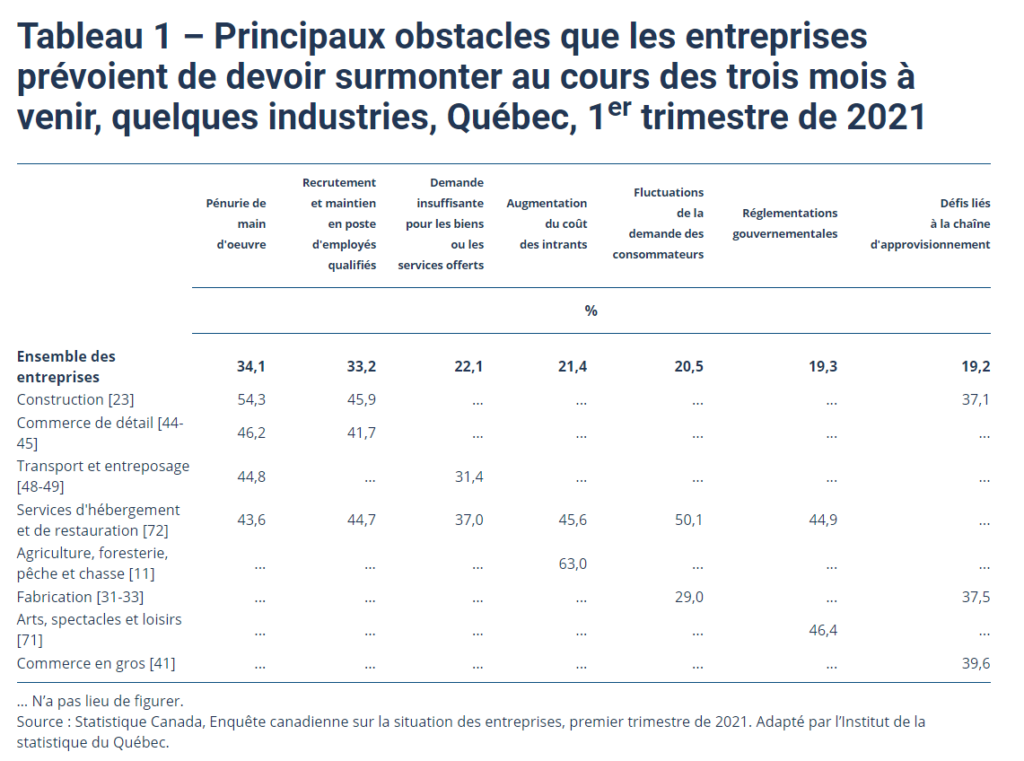
(Table available in French only.)
The primary cause for labour market scarcity is a sustained decline in the labour force in Quebec and Canada. This phenomenon can be explained by the fact that many baby boomers are retiring.
A BDC study shows the strategy companies are preferring to counter this shortage is to hire less qualified or less experienced workers and then train them in-house.
Developing skills on the job through e-learning is therefore a solution in this case.
E-learning, a flexible and self-guided solution for quick training
One of the reasons labour shortages are a barrier to organizations is that they increase existing employees’ workloads. Once they are hired, new employees are quickly put to task to restore a balanced workload. A training pit stop, therefore, is essential to guarantee their success.
E-learning perfectly meets the need to train new employees quickly thanks to the flexibility of its on-demand format. As soon as they are hired, new recruits can independently browse a training course catalogue and acquire a solid foundation upon which they can rely to start their onboarding.
Because it is complementary to mentoring sessions, online training enhances them. In fact, since the employee already learned basic and general notions in the online courses, a mentor’s teaching can then focus on working knowledge, on challenging work tasks or simply to make time to learn how to work together.
In the end, welcoming and onboarding a new employee into a team that is feeling the pressure due the shortage can become significantly easier using e-learning.
Sources :
https://statistique.quebec.ca/fr/produit/publication/attentes-entreprises-quebec-premier-trimestre-2021-contexte-pandemie-de-covid-19#faits
https://www.bdc.ca/fr/a-propos/analyses-recherche/penurie-main-doeuvre
Contact us
Has this article piqued your interest? Do you want to discuss e-learning solutions tailored to your needs? Get in touch now using the form below!
This site is protected by reCAPTCHA and the Google Privacy Policy and the Terms of Services apply.
Happiness as a company driving force
Happiness as a company driving force
In episode 257 of the Simpsons, the most intellectually gifted character, Lisa, “demonstrates” that “as intelligence increases, happiness decreases” but, as the Australian economist Justin Wolfers showed, it is not quite as simple as that.
The most educated people tend to earn higher wages, they possess a more diversified vocabulary and, consequently, are more likely to experience a variety of feelings and communicate them.
Ignorance does not guarantee happiness; in fact the reverse is true.
Why take an interest in happiness?
As Aristotle said, “Happiness is the supreme Good. It is the unconditional purpose of human existence."
Being happy is not limited to feeling good: research shows that it is also good for health, productivity and goodwill! Happiness is linked to what we feel but it goes beyond a simple state of mind. We are emotional beings and we experience a wide spectrum of feelings on a daily basis. Negative feelings — such as fear and anger — help us to flee danger and defend ourselves. Positive feelings — such as pleasure and hope — help us to connect with others and build our capacity to survive the worst circumstances.
Most important, perhaps, is the fact that happy people are more inclined to contribute positively to society. They are more likely to vote, commit to voluntary work and participate in public activities.
If you are reading this, you have probably read other articles on happiness at work. Most present a list of things that make us happy: transparency of communication, trust, empowerment, recognition, clarity, wages, control, belonging, interest, meaning — most often associated with an amusing idea such as free sodas, a happy hour or taking your parrot to the office.
“Individuals differ enormously in terms of what makes them happy — for some, competition, victory and riches are great sources of happiness; for others, competence and socialisation are more important,” says the American psychologist Steven Reiss.
His argument: happiness is not a generic solution.
From a quantitative research point of view, behaviourists have identified 23 sources of motivation at work, from Creativity to Impact and Development of others to Wages. Their conclusion is as follows: if you wish to be “happy" at your work and perform at full capacity, it is essential to dig deeper and understand a few of these sources of motivation.
7 ways to stimulate happiness, validated by science
- See the fruit of our work make us more productive.
- The less we feel appreciated for our work, the more money we want to do it.
- The more a project is difficult, the prouder we feel in accomplishing it.
- Knowing that our work helps others stimulates intrinsic motivation.
- The promise of helping others makes us more inclined to obey the rules.
- Positive reinforcement concerning our abilities increases performance.
- Images that generate positive feelings increase concentration.
Happiness as a business strategy
Happiness’s big brother, well-being, is a concept that was incorporated into economic science a long time ago. Unlike happiness, which is often received with scepticism when evoked in terms of “measure,” well-being is easier to analyse. Initially, subjective well-being was seen as difficult to measure but when we want to, we can.
The examples are numerous in terms of business strategy. For example, Amazon offers its employees working in warehouses $5,000 if they decide to resign. Strange as it may seem, there is a logical reason behind this initiative.
The CEO, Jeff Bezos, describes his HR strategy: “In the long run, an employee who stays although he doesn't want to is neither good for him nor for the company […] The objective is to encourage our associates to reflect on what they really want.”
Employees’ commitment may seem superfluous in a difficult economic context but it may make a difference to the survival of companies. In a study conducted in 2010, Gallup’s director of well-being at work, James Harter and his colleagues, showed that a low level of satisfaction was the precursor to low financial performance. When people cease to care about their job and their employers, they are increasingly absent, produce less and the quality of work suffers.
The research shows that an inner life at work has a profound impact on the creativity, productivity, commitment and collegiality
of employees. They are more likely to have new ideas when they feel happy. Popular wisdom suggests that pressure improves performance — our data, however, shows that performance is improved when associates are happy to be involved in what they are doing.
Managers can make sure that people are happy to be involved at work. This does not necessarily generate any extra costs. The well-being of associates depends, for the most part, on the ability and will of managers to facilitate the accomplishment of associates — by removing obstacles, providing assistance and acknowledging the effort.
Adults spend the majority of their waking hours at work. Work should revive rather than kill the human spirit. Promoting the well-being of associates is not only ethical, it is economically smart.
Favouring a positive inner life requires from leaders that they articulate the meaning they give to work in order to reach all associates in the organisation.
- Daniel Lacombe, Senior Consultant, Sage Consulting
Sources : Freakonomics, The Guardian, Inc.com, TED.com, The New York Times.
Can happiness be bought?
Can happiness be bought?
It turns out that whoever said that money does not buy happiness was wrong.
Money can buy happiness, for example, if you give it away or use it to buy an experience rather than a product.
Research to date has been unable to show definitively that rich people are happier than the less rich but certain studies seem to indicate that this is effectively the case.
According to the researchers behind the Princeton study, well-being — or the pleasure derived from daily experiences — no longer increases when your household reaches an income level of US$75,000.
That said, “assessment of your life" or how you feel with regard to your life and your accomplishments, can continue to grow at higher levels of income and education.
Happiness and energy
The productivity of happy people is explained by their capacity to recognise that their level of energy depends not only on their physical state (illness, fatigue, etc.) but also on their psychological state. People are happy quite simply because they think they are capable of being happy.
Subjective vitality increases when the psychological requirements of independence, skill and belonging are fulfilled.
Remember the role independence plays with regard to energy levels; compare, for example, the effect of an action originating from an independent decision or an action subject to an outside demand on our thinking or behaviour.
While independent behaviour may maintain or increase the level of energy, controlled behaviour tends to lower it. As a manager, this means that giving more latitude to associates may improve their feeling of well-being and perhaps their productivity as well.
A study made it possible to note that when patients in a weight-loss clinic are motivated to follow a treatment for external reasons, they show less vitality than those who are there for reasons determined independently.
This clearly shows that intrinsic motivation increases the level of subjective vitality and the perceived level of energy. We also retain that independence can generate feelings of energy and well-being. In conclusion, if you want to raise your energy level and that of your associates, make sure you delegate the power of decision to them for their own tasks.
Happiness and confidence
The level of confidence in a working environment serves to predict its level of happiness, the economist John F. Helliwell tells us. Helliwell decided to conduct an economic analysis of well-being and discovered a number of factors that influence happiness. The nature of the work leads the way obviously but direct contact between colleagues and with management has a considerable impact.
It is nevertheless not as simple as just saying “trust me.” Several politicians have made it next to impossible to believe in this formula! Trust has to be shown by behaviour, ideally, outside dedicated sessions.
One of the actions that obtains a high score in perceived trust is encouraging common involvement throughout the organisation, from bottom to top.
These ideas must come from the members of the organisation themselves. Since trust is established by collective action, this decision can not come from senior management. Collective action embodies two other key elements of well-being: commitment and efficiency. This is why voluntary assignments are useful, they make it possible to work together in a different context.
Trust is asymmetric however. Once lost, it is difficult to win back. There are undoubtedly many workplaces in which the people are aware of the low level of trust and the scale of investment required to repair the harm done.
Remember that all human beings must enter into a relationship sooner or later. If it is impossible to use this time of connection to create a positive, shared commitment, the time will be lost in internal political conflicts. The connection is made but the result is not the same!
Happiness and creativity
“Reverse the happiness and success formula. We think we will happier by working harder and achieving a goal but research shows that each success changes what the brain perceives as a success. If, for you and your team, happiness is the opposite of success, you will never get there. However, if you improve your level of happiness during a difficult period — by seeking an investment in an unfavourable economic context for example — the level of success increases considerably.” - Shawn Achor, The Happiness Advantage
The key elements of the creative personality, such as the search for novelty and perseverance, are good indicators of satisfaction. This works both ways: we tend to be more creative when we are predisposed, possibly because we do not concentrate on partial information but rather on the overall view. A study showed that happy doctors diagnose twice as fast! - Rowe & Hirsch, 2007.
“Committing to a creative quest allows individuals to explore their identity, cultivate their skills and reflect on the state of the world in a critical manner. In their turn, this self-knowledge and these relationships serve as sources of strength and resilience.” - Paul Silvia, University of North Carolina.
Laughter at work
Recent studies have revealed that laughter can contribute to your health and performance at work by stimulating your immune system, increasing blood circulation, and reducing stress for a period lasting up to 45 minutes. Ten minutes of laughter burn approximately 50 calories, which lets you eat another biscuit (a small one)! Not forgetting the social benefits of laughter: better communication, team work, creation of links and mitigation of conflicts!
Introducing pleasure at work is not new. The President of Southwest Airlines, Herb Kelleher, well-known for his light approach to business, proposing to resolve a legal matter with an arm-wrestling match (which he won) or arriving at work dressed like Elvis. The ice cream manufacturer Ben & Jerry’s has what it calls its “Joy Gang,” a group of employees who encourage the organisation of amusing activities such as spontaneous theatre plays or theme meals. Richard Branson, the prolific founder of Virgin, places his employees at the centre of his business strategy; he operates according to the following formula: happy employees make happy clients.
Even if your company does not have systems such as these, do not forget to have fun at work and laugh more to achieve real satisfaction at work and really love what you are doing.
Editors
Daniel Lacombe, Senoir Consultant, Sage Consulting
Béatrice Loubier, Instructional Designer, Novaconcept, Québec
Sources : Freakonomics, The Guardian, Inc.com, TED.com, The New York Times, Huffington post
Minka, a Serious Game Example Showing the Gamification of Learning.
Minka, a serious game for learning
Why do games have a childish connotation? Is it adulthood snobbery to want to relegate games to mere entertainment? It’s quite possible, but if we look beyond this connotation, games have a lot to offer us, especially in skills development.
At Novaconcept, we are convinced that games are a very serious lever for learning in business. This is why we developed MINKA, a collaborative and educational gaming platform. How does it work in two sentences? The learners grouped into rival teams answer a series of questions organized by level. Jokers and bonuses help and spice up their respective courses. In short, the MINKA platform is based on a playful and fragmented learning approach.
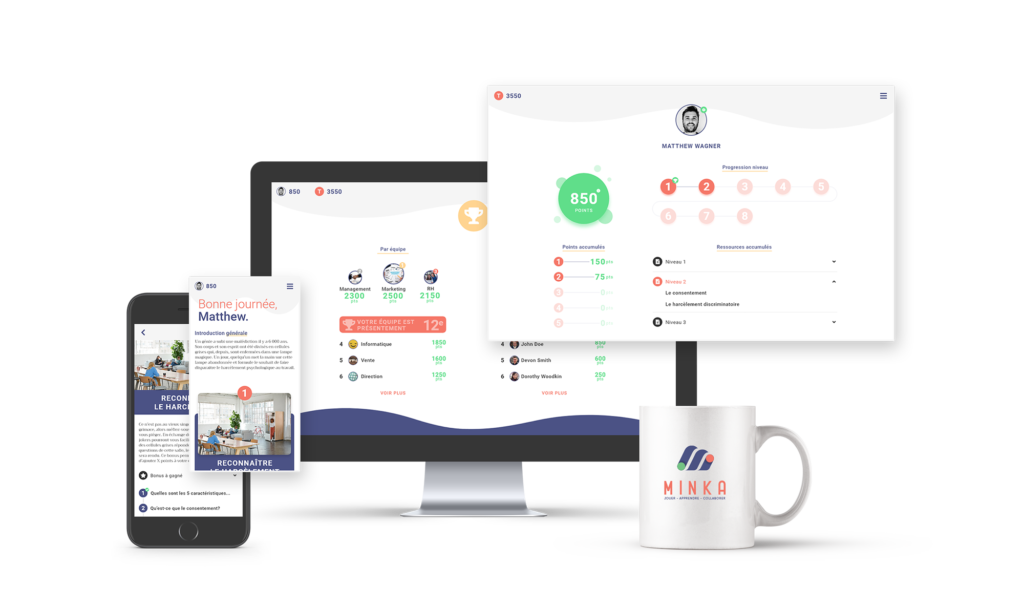
Almost convinced of the approach? Here is our reasoning.
Acquiring new skills is a process that requires the learner to invest. It’s an investment in time and concentration that pays little in the short term, but whose results are more obvious in the medium and long term. The simple will to learn for the sake of learning is often strained by the accomplishment of everyday tasks. Motivation and energy are lacking when it comes to training.
What if, to motivate employees, you had to tap into another register and seek commitment in another form? A form where the reward is more immediate, where the positive reinforcement effect pushes for continuous improvement. Games have the ability to awaken motivation and make us think twice.
This is known in technical jargon as “gamification,” that is to say the addition of design and game mechanisms to contexts that are usually devoid of them.
Online training is particularly conducive to gamification, as connections with the video game world can easily be made. For our collaborative and educational platform, we have relied on two well-known game mechanisms to generate engagement: collaboration and competition.
- Collaboration motivates learners in that it spontaneously creates a feeling of belonging and a strong team spirit.
- Competition, for its part, seeks the motivation of learners who want to measure themselves against their game opponents and obtain positive results.
Finally, let’s not forget that motivation has a time dimension. Just like concentration, learner motivation decreases when subjected to time: therefore the more time passes, the less learners are motivated.
The solution: break the content into bite-size pieces so as not to give learners time to lose their appetite for learning. The benefits of fragmentation don’t end there; it also contributes to better retention of content in learners.
A study1 has shown that a group exposed to content cut into several pieces, interspersed with questions, performs better than a group exposed to the same content, presented in a block and followed by the same number of questions. Afterwards, an evaluation was conducted and found that the group of learners subjected to the fragmented content recorded a success 20% higher than the other group, while taking 28% less time to complete the evaluation. It’s pretty significant, don’t you think?
Far from being childish, games know how to captivate, mobilize and motivate. These are qualities that we want to use for the development of skills within companies.
To learn more about Minka, visit the link below or contact us at : minka@novaconcept.com
References
(1) Kapp, F., Proske, A., Narciss, S., & Körndle, H. (2015). Distributing vs. blocking learning questions in a web-based learning environment. Journal of Educational Computing Research, 51(4), 397-416. doi:10.2190/EC.51.4.b
How Much Does it Cost to Create a E-learning Course?
I am often asked: “How much does it cost to design and produce a 30-minute online course?” To that, I always answer the same thing: “How much does a 30-second ad on TV cost?” You will therefore understand that it depends on a multitude of factors…
I therefore suggest three questions to ask yourself to determine your e-learning budget.
First question, how do you plan to allocate the necessary resources?
There are many ways to collaborate with e-learning experts, and depending on your internal resources, availability, and timeline, you may choose to outsource the design or part of it to us. Some clients provide us with their own script, for review or not, while other clients often hire our instructional designers to produce a script from raw content.
Now, what is the desired level of interactivity?
Depending on whether the course objectives are formative or informative, you must determine the desired level of interactivity. Interactivity can be:
• non-existent, with strictly linear animated content,
• limited, with a menu and multiple choice questions, for example,
• moderate, we are talking about essay questions, connection, integration of elements of varied content,
• or immersive, with custom feedback, simulations, avatars, etc.
Of course, our experts are there to guide you in this decision and ensure that the chosen format serves the content well, but it is important that this decision be made ahead of the project since it has a significant impact on the budget. With this information in hand, you are now able to answer the following question: what is the production’s complexity level?
The production includes scriptwriting, graphic design, integration and programming. A variety of elements impact the complexity level. They include:
- the content level (from simple to expert),
- graphic elements (use of existing equipment versus development of custom graphic elements),
- navigation needs (linear, contextual documents, connections to several scenarios),
- shooting of videos or taking photos,
- assessing learning and using a passing grade.
This information is used to determine the number and expertise of resources to be assigned to the project, the number of person-hours for each specialty and the needs in terms of other resources (actors, storytelling and/or filming studio, artistic director, etc.)
It goes without saying that the answers to these questions should come from a discussion with internal experts and your favourite e-learning partner! It is important to involve all stakeholders from the start to share a common vision of the final product—an essential element for the smooth running of the project—within the allocated budget.
For more informations on our services, do not hesitate to visit this section of our website or contact us!
Ghislain Bélanger
Chief Executive Officer

